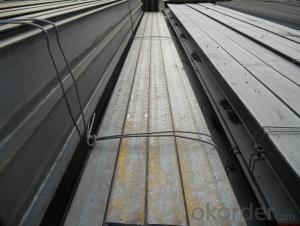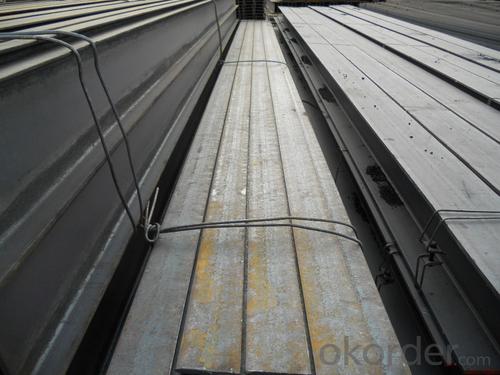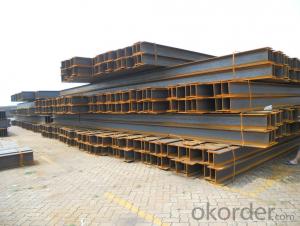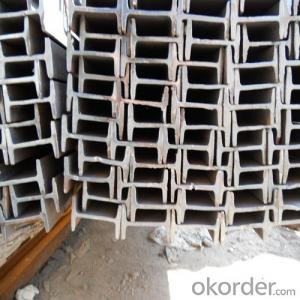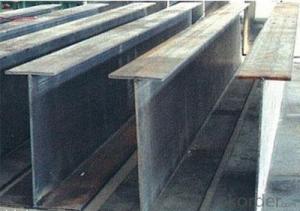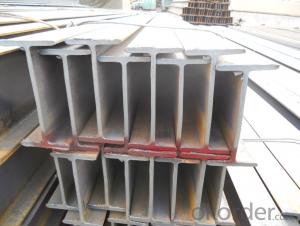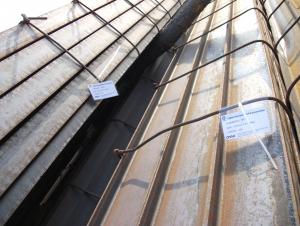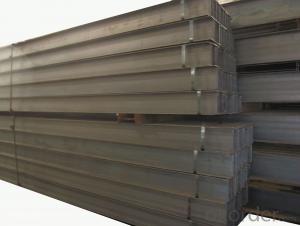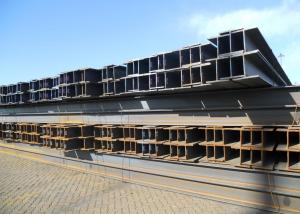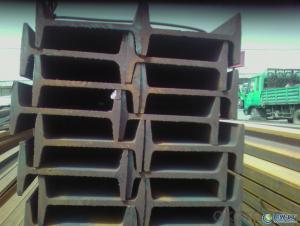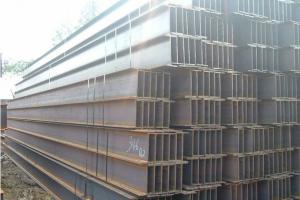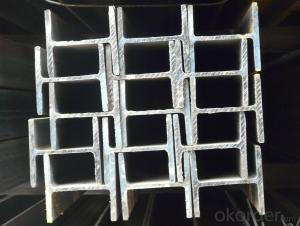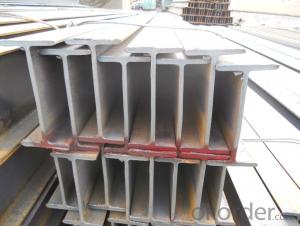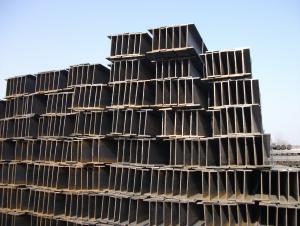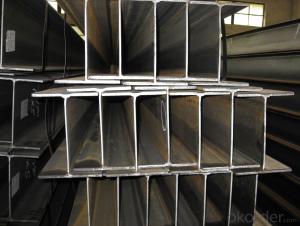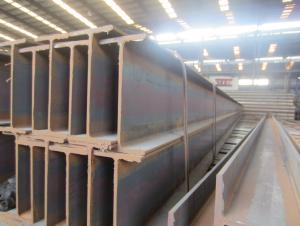Hot Rolled Low Carbon H Beam at Length 12m
- Loading Port:
- China main port
- Payment Terms:
- TT OR LC
- Min Order Qty:
- 100 m.t.
- Supply Capability:
- 10000 m.t./month
OKorder Service Pledge
OKorder Financial Service
You Might Also Like
Product Description:
OKorder is offering Hot Rolled Low Carbon H Beam at Length 12m at great prices with worldwide shipping. Our supplier is a world-class manufacturer of steel, with our products utilized the world over. OKorder annually supplies products to African, South American and Asian markets. We provide quotations within 24 hours of receiving an inquiry and guarantee competitive prices.
Product Applications:
Hot Rolled Low Carbon H Beam at Length 12m are ideal for structural applications and are widely used in the construction of buildings and bridges, and the manufacturing, petrochemical, and transportation industries.
Product Advantages:
OKorder's Hot Rolled Low Carbon H Beam at Length 12m are durable, strong, and wide variety of sizes.
Main Product Features:
· Premium quality
· Prompt delivery & seaworthy packing (30 days after receiving deposit)
· Can be recycled and reused
· Mill test certification
· Professional Service
· Competitive pricing
Product Specifications:
Manufacture: Hot rolled
Grade: Q195 – 235
Certificates: ISO, SGS, BV, CIQ
Length: 12m
Packaging: Export packing, nude packing, bundled
| size | h (MM) | b (MM) | t1 (MM) | t2 (MM) | theoretical kg/m | length |
| 100*100 | 100 | 100 | 6 | 8 | 16.9 | 12m |
| 125*125 | 125 | 125 | 6.5 | 9 | 23.6 | 12m |
| 150*75 | 150 | 75 | 5 | 7 | 14 | 12m |
| 150*150 | 150 | 150 | 7 | 10 | 31.1 | 12m |
| 148*100 | 148 | 100 | 6 | 9 | 20.7 | 12m |
| 198*99 | 198 | 99 | 4.5 | 7 | 17.8 | 12m |
| 200*100 | 200 | 100 | 5.5 | 8 | 20.9 | 12m |
| 248*124 | 248 | 124 | 5 | 8 | 25.1 | 12m |
| 250*125 | 250 | 125 | 6 | 9 | 29 | 12m |
| 300*150 | 300 | 150 | 6.5 | 9 | 36.7 | 12m |
| 298*149 | 298 | 149 | 5.5 | 8 | 32 | 12m |
| 200*200 | 200 | 200 | 8 | 12 | 49.9 | 12m |
| 294*200 | 294 | 200 | 8 | 12 | 55.8 | 12m |
| 346*174 | 346 | 174 | 6 | 9 | 41.2 | 12m |
| 350*175 | 350 | 175 | 7 | 11 | 49.4 | 12m |
| 244*175 | 244 | 175 | 7 | 11 | 43.6 | 12m |
| 175*175 | 175 | 175 | 5 | 11 | 40.4 | 12m |
| 294*200 | 294 | 200 | 8 | 12 | 55.8 | 12m |
| 346*174 | 346 | 174 | 6 | 9 | 41.2 | 12m |
| 350*175 | 350 | 175 | 7 | 11 | 49.4 | 12m |
| 400*200 | 400 | 200 | 8 | 13 | 65.4 | 12m |
| 396*199 | 396 | 199 | 7 | 11 | 56.1 | 12m |
| 450*200 | 450 | 200 | 9 | 14 | 74.9 | 12m |
| 446*199 | 446 | 199 | 8 | 12 | 65.1 | 12m |
| 340*250 | 340 | 250 | 9 | 14 | 78.1 | 12m |
| 500*200 | 500 | 200 | 10 | 16 | 88.1 | 12m |
| 300*150 | 300 | 150 | 6.5 | 9 | 36.7 | 12m |
FAQ:
Q1: Why buy Materials & Equipment from OKorder.com?
A1: All products offered byOKorder.com are carefully selected from China's most reliable manufacturing enterprises. Through its ISO certifications, OKorder.com adheres to the highest standards and a commitment to supply chain safety and customer satisfaction.
Q2: what is the difference between actual weight and theoretical weight?
A2: All the section steel has two weights: actual weight and theoretical weight. Actual weight is the weighing out when the product delivered from the mill. Theoretical weight is calculated by pieces. The invoice can be based on each of them as your request.
Q3: How many tons of steel products could be loaded in containers?
A3: Usually the steel products are delivered by bulk vessel because of the large quantity and the freight. However, there are no bulk vessel enter some seaports so that we have to deliver the cargo by containers. The 6m steel product can be loaded in 20FT container, but the quantity is changed according to the size, usually from 18tons to 25tons.
Images:
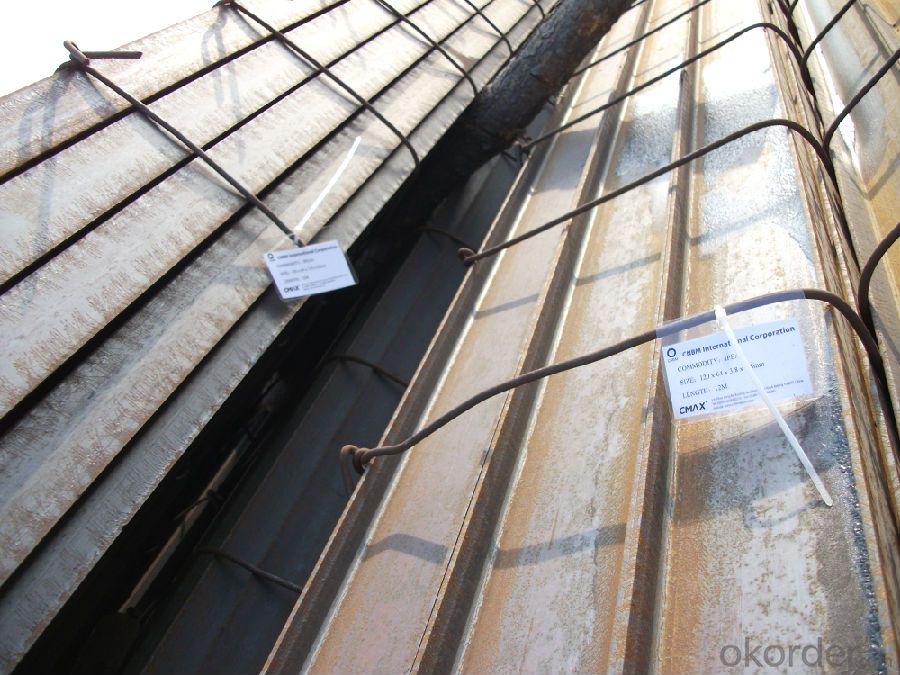
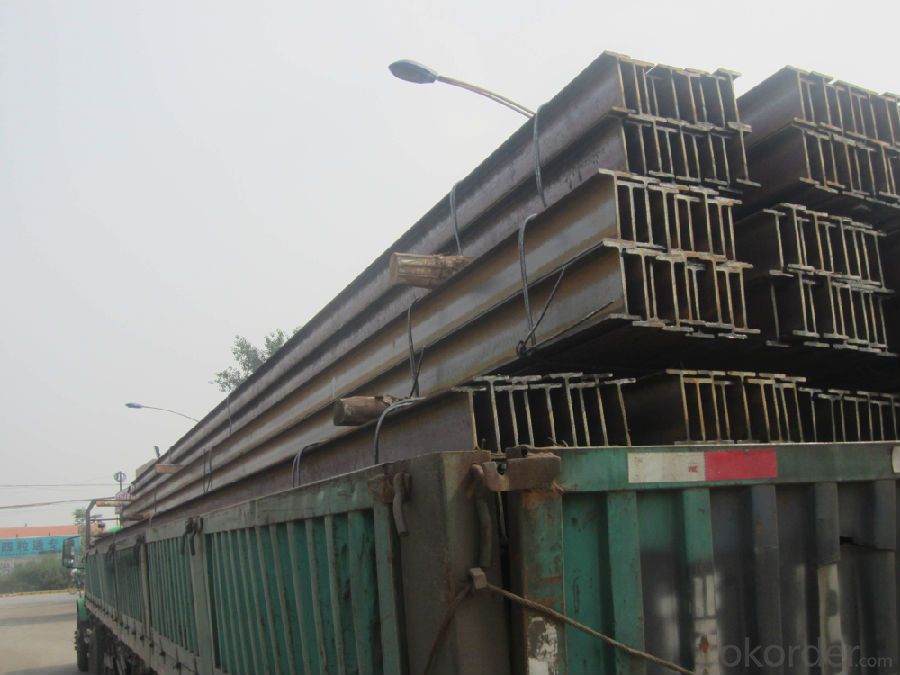
- Q: What are the different types of welding used for steel H-beams?
- There are several types of welding commonly used for steel H-beams, including shielded metal arc welding (SMAW), gas metal arc welding (GMAW), flux-cored arc welding (FCAW), and submerged arc welding (SAW). Each of these methods has its advantages and is chosen based on factors such as the thickness of the steel, the desired strength, and the specific application requirements.
- Q: What are the different types of coatings available for fire protection of steel H-beams?
- Fire protection coatings for steel H-beams come in several different types, each designed to enhance fire resistance and prevent weakening or collapse during a fire event. The most commonly used type is intumescent coatings. These coatings contain special chemicals that expand when exposed to heat, creating a charred layer that insulates the steel and slows heat transfer. They provide excellent fire resistance and can withstand high temperatures for an extended period. Another type is cementitious coatings, made from a mixture of cement, fillers, and binders. These coatings form a hard, durable layer that acts as a heat barrier. They are thick, providing good fire resistance, and are also resistant to impact and abrasion, making them suitable for high-risk areas. Reactive coatings are also available. These coatings contain chemicals that react at high temperatures, releasing fire-retardant gases or water vapor. This reaction cools down the steel and prevents it from reaching critical temperature. Reactive coatings are effective in providing fire resistance and are often used in areas with limited space for insulation. Vermiculite coatings consist of lightweight, granular material mixed with a binder and sprayed onto steel beams. When exposed to heat, vermiculite expands, forming an insulating layer that protects the steel. This type of coating is ideal for buildings where weight is a concern, as it is lightweight and adds minimal load to the structure. Intumescent paint is a type of fire protection coating that expands like foam when exposed to high temperatures. It is applied like regular paint and creates a layer that insulates the steel and slows down heat transfer. Intumescent paint is commonly used in areas where aesthetics are important, as it comes in various colors and finishes. It is important to consider factors such as required fire rating, duration of fire resistance, environmental conditions, and specific application when choosing a coating. Consulting a fire protection engineer or specialist is recommended to determine the most suitable coating for a specific project.
- Q: How are steel H-beams specified in construction drawings?
- Construction drawings provide detailed information about the dimensions, material properties, and other relevant specifications of steel H-beams used in construction. These specifications typically include: 1. Size: The H-beam's size is determined by its depth, width, and weight per unit length. Depth refers to the vertical distance between the top and bottom flanges, width denotes the horizontal distance across the flanges, and weight per unit length indicates the amount of steel used. 2. Material: The drawings specify the type of steel material used for the H-beam, its grade, and any additional requirements. Common materials include carbon steel, high-strength low-alloy steel, and stainless steel. 3. Profile: The drawings also specify the profile of the H-beam, which includes the shape of the flanges and the web. The profile can be standard or customized based on project requirements. 4. Tolerances: Tolerances for dimensions, straightness, and other parameters are specified to ensure the H-beams meet required standards and can be accurately fabricated. 5. Connections: The drawings specify the type of connections to be used with the H-beams, such as bolted or welded connections. This information helps determine the appropriate design and fabrication details for the connections. 6. Finishes: If specific finishes or coatings are required, such as galvanizing or painting, they are specified in the drawings to ensure proper protection and aesthetics. 7. Marking: Each H-beam is marked with a unique identification number or symbol, and these marking details are specified in the drawings to ensure traceability and identification during fabrication and installation. By including these specifications in the construction drawings, architects, engineers, and fabricators can ensure that the steel H-beams used in the construction project meet design requirements, regulatory standards, and quality expectations.
- Q: Are steel H-beams suitable for overhead cranes?
- Yes, steel H-beams are suitable for overhead cranes. H-beams are commonly used in the construction industry due to their high strength and durability. They provide excellent load-bearing capabilities, making them ideal for supporting heavy loads, such as those encountered in overhead crane applications. The structural design of H-beams allows for optimal weight distribution and efficient load transfer, ensuring the stability and safety of the crane system. Moreover, steel H-beams can be easily fabricated and welded, making them versatile and adaptable to various crane configurations and requirements. Overall, steel H-beams are a reliable and effective choice for overhead crane construction.
- Q: Are steel H-beams suitable for residential extensions?
- Indeed, residential extensions can be aptly accommodated by steel H-beams. These beams are widely employed in construction owing to their robust structural integrity and ability to bear substantial loads. They offer exceptional reinforcement for supplementary floors, extensions to roofs, and other alterations within residential edifices. Steel H-beams present numerous benefits, encompassing durability, longevity, and resistance against fire, moisture, and pests. Furthermore, they facilitate versatile architectural designs and can be seamlessly integrated into diverse construction systems. All in all, steel H-beams stand as a dependable and efficient selection for residential extensions, guaranteeing the stability and security of the structure.
- Q: What are the different types of steel H-beam profiles?
- There are various types of steel H-beam profiles, each designed to serve different purposes and applications. Some of the common types include: 1. Standard H-beam: This is the most commonly used type of H-beam profile. It features a wide flange and tapered web, making it suitable for various structural applications. 2. Wide flange (W) beam: This type of H-beam profile has a wider flange, offering increased stability and load-bearing capacity. It is commonly used in construction projects requiring strong support beams. 3. American standard beam (S): Also known as S-beams, these H-beams have a narrower flange and thinner web compared to standard H-beams. They are commonly used in smaller-scale construction projects. 4. European standard beam (HEA/HEB/HEM): These H-beams conform to European standards and have a wider flange than standard H-beams. They are commonly used in construction projects in Europe. 5. Japanese standard beam (JIS): These H-beams adhere to Japanese industrial standards and are commonly used in construction projects in Japan. They have a wide flange and thick web, providing excellent load-bearing capabilities. 6. Light H-beam: As the name suggests, this type of H-beam profile is lighter in weight compared to standard H-beams. It is commonly used in applications where weight reduction is necessary, such as in lightweight construction or transportation. 7. Special profiles: There are also various specialized H-beam profiles available, such as those with rounded corners or unique shapes. These profiles are designed to meet specific requirements or architectural aesthetics. Overall, the choice of H-beam profile depends on factors such as load-bearing capacity, structural requirements, and regional standards.
- Q: H steel column calculationHow do you calculate the amount? And what are the steps and formulas for this calculation?
- H steel is welded; HWHMHN is the hot rolled HW H steel is the height and width of flange is basically the same; mainly used for reinforced concrete frame column steel column, also known as rigid steel column; in steel structure is mainly used for HM H type steel column and steel I-beam flange height of airfoil is a variable cross-section on web portion thick and thin outer flange; H steel is uniform HWHMHNH is known as H steel
- Q: What are the common finishes available for steel H-beams?
- There are several common finishes available for steel H-beams, depending on the specific requirements and desired appearance. Some of the most commonly used finishes include: 1. Mill Finish: This is the most basic finish available for steel H-beams. It is the result of the manufacturing process and does not undergo any additional treatments or processes. As a result, it has a raw, untreated appearance with a slightly rough texture. 2. Hot-dip Galvanized: This finish involves immersing the steel H-beams in a bath of molten zinc, creating a protective coating. The process provides excellent corrosion resistance, making it suitable for outdoor applications where the beams may be exposed to harsh environmental conditions. 3. Primer Coating: Steel H-beams can also be coated with a primer, which acts as a protective layer against corrosion. This finish is commonly used when the beams will be further painted or coated with another layer of protective material. 4. Powder Coating: Powder coating is a popular finish option that involves applying a dry powder to the surface of the steel beams. The powder is then heated, causing it to melt and form a durable, protective layer. Powder coating offers a wide range of color options, as well as enhanced resistance to scratches, chipping, and fading. 5. Painted Finish: Steel H-beams can also be painted using traditional liquid paint. This finish provides a customizable appearance, as the beams can be painted in any desired color. However, it may require periodic maintenance and touch-ups to ensure long-term protection against corrosion. It is important to note that the specific finishes available may vary depending on the manufacturer or supplier. Therefore, it is advisable to consult with a professional or refer to the product specifications to determine the available finishes for steel H-beams.
- Q: How do steel H-beams perform in coastal or saltwater environments?
- Steel H-beams perform reasonably well in coastal or saltwater environments, but they require proper maintenance and protective measures to prevent corrosion. The presence of saltwater and high humidity in coastal areas creates a corrosive environment that can accelerate the deterioration of steel. However, steel H-beams are commonly used in coastal construction projects due to their strength, durability, and cost-effectiveness. To ensure their performance and longevity in such environments, several considerations need to be taken into account. Firstly, the use of corrosion-resistant coatings is essential. Applying coatings such as epoxy, zinc, or galvanization can significantly enhance the steel's resistance to saltwater corrosion. These coatings act as a barrier between the steel and the corrosive environment, preventing direct contact and inhibiting the oxidation process. Regular inspections and maintenance are also crucial in coastal or saltwater areas. Inspecting the H-beams for any signs of corrosion, such as rust or pitting, is necessary to identify and address any early stages of deterioration. Any damaged or compromised protective coatings should be repaired or replaced promptly to prevent further corrosion. Furthermore, proper drainage and ventilation systems need to be in place to minimize the accumulation of saltwater and moisture on the steel surfaces. Excessive moisture or prolonged exposure to saltwater can speed up the corrosion process, leading to structural integrity issues. Adequate ventilation allows for the circulation of air, reducing the chances of moisture buildup and providing a more favorable environment for the steel. It is important to note that the performance of steel H-beams in coastal or saltwater environments also depends on the specific grade and quality of steel used. Choosing high-quality corrosion-resistant steel, such as stainless steel or weathering steel, can provide enhanced protection against saltwater corrosion. In conclusion, while steel H-beams can perform well in coastal or saltwater environments, it is crucial to implement proper maintenance and protective measures. Utilizing corrosion-resistant coatings, conducting regular inspections, ensuring proper drainage and ventilation, and selecting high-quality steel can all contribute to their long-term performance and durability in such challenging environments.
- Q: How do Steel H-Beams contribute to the overall occupant productivity of a building?
- Steel H-Beams contribute to the overall occupant productivity of a building by providing structural support and enhancing the stability of the structure. These beams are known for their strength and durability, which allows for larger open spaces and flexible floor layouts. This leads to a more efficient use of space, allowing occupants to have more room for their work activities. Additionally, steel H-Beams are fire-resistant and can withstand extreme weather conditions, ensuring the safety and comfort of occupants. Overall, the use of steel H-Beams in a building helps create a conducive environment for increased occupant productivity.
Send your message to us
Hot Rolled Low Carbon H Beam at Length 12m
- Loading Port:
- China main port
- Payment Terms:
- TT OR LC
- Min Order Qty:
- 100 m.t.
- Supply Capability:
- 10000 m.t./month
OKorder Service Pledge
OKorder Financial Service
Similar products
Hot products
Hot Searches
Related keywords
